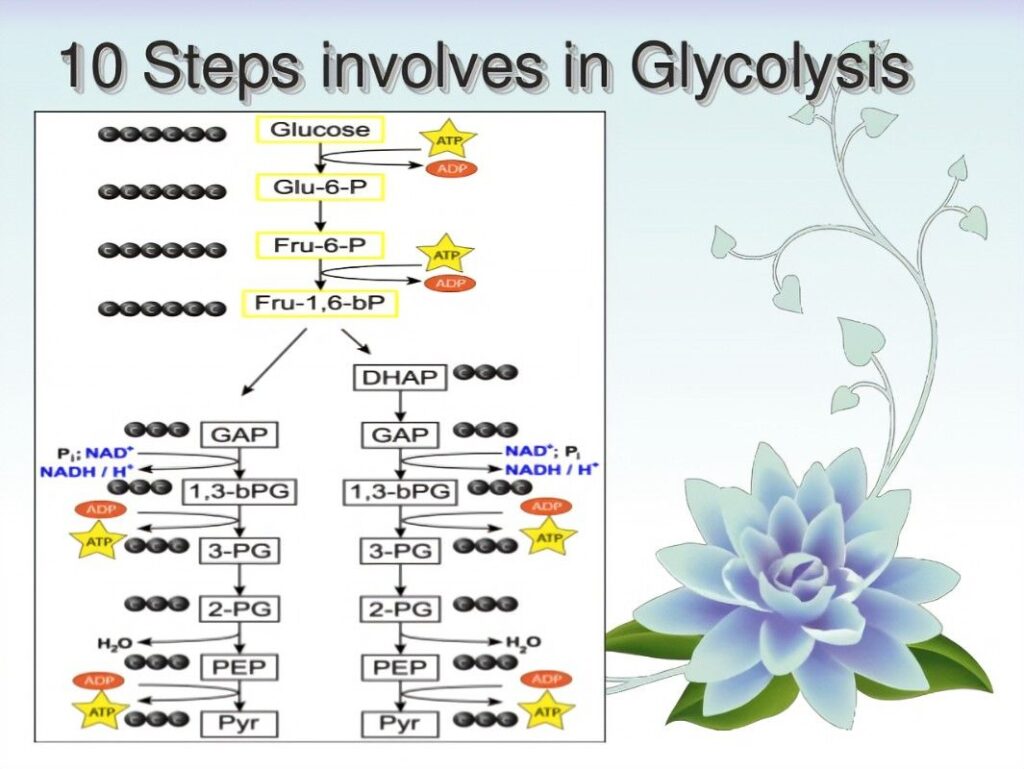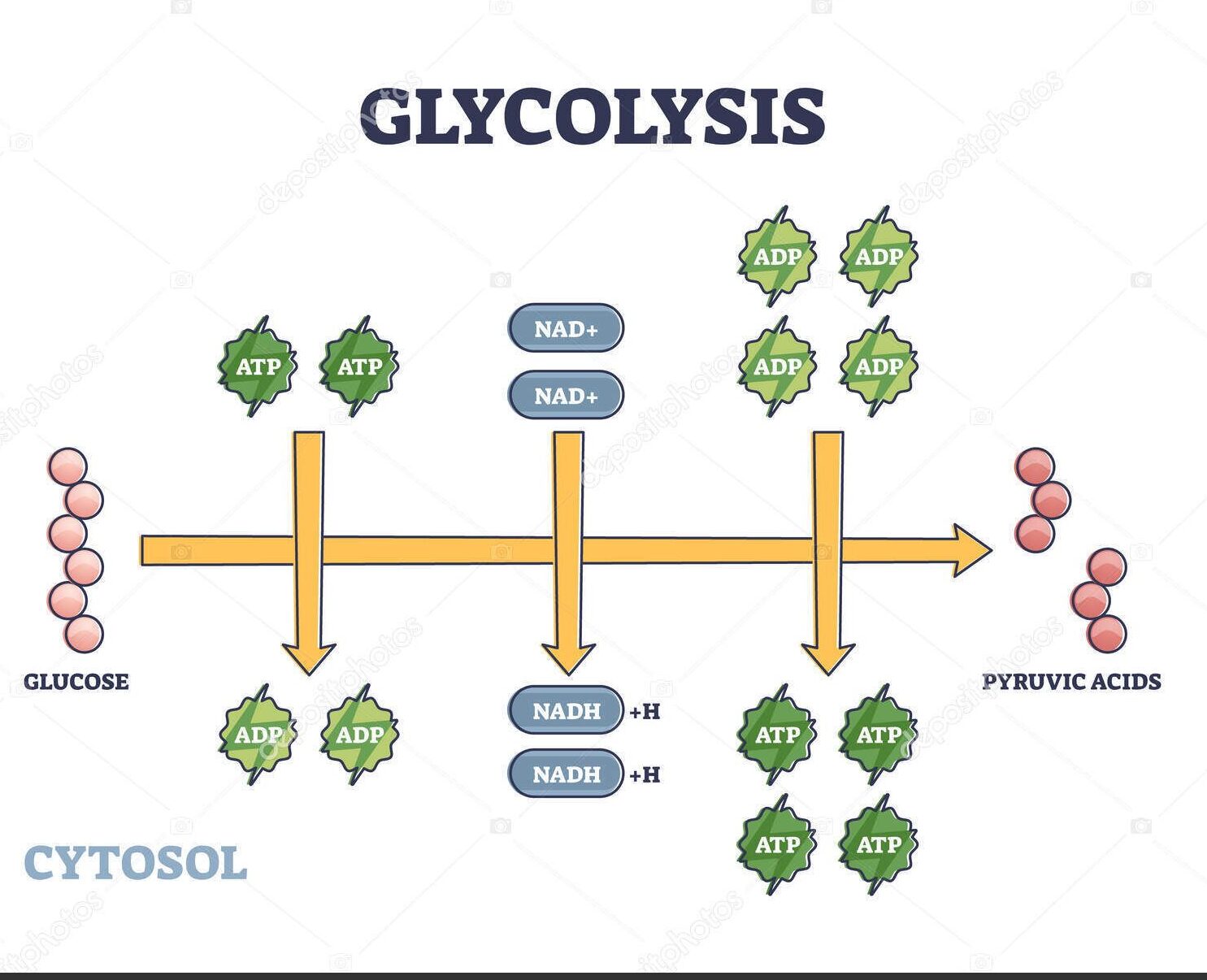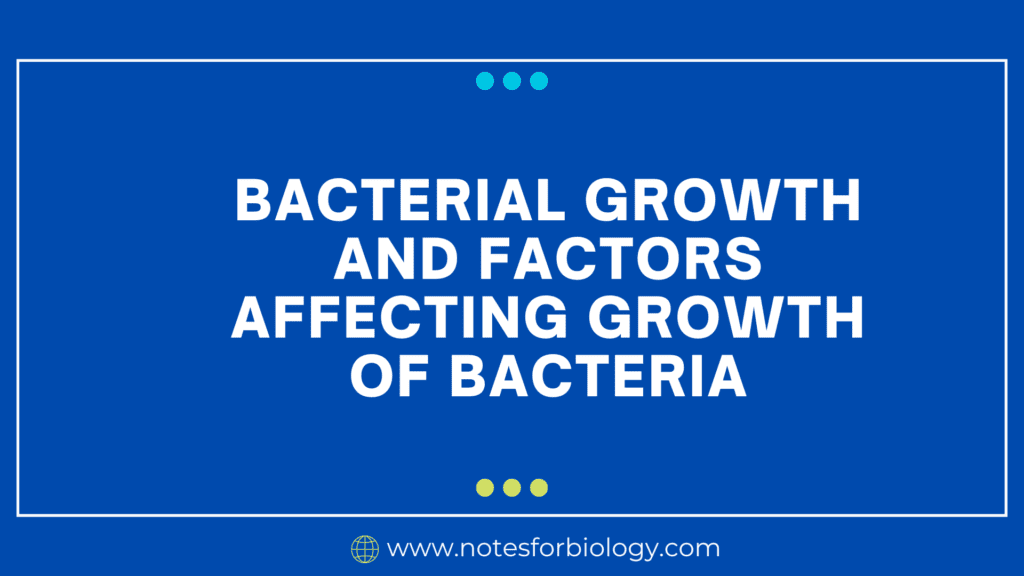Introduction: What is Glycolysis?
Glycolysis is a central metabolic pathway found in almost every living organism—from tiny bacteria to humans. It is the first step in the breakdown of glucose, the most basic sugar molecule that serves as fuel for our cells. The word “glycolysis” comes from Greek: “glyco” means sugar, and “lysis” means splitting. So, glycolysis literally means “splitting sugar”.
But it is more than just cutting glucose in half. It’s the first chapter of a much larger story—the story of how cells extract energy from food to survive, grow, and carry out their daily functions.
Table of Contents
Why is Glycolysis Important?
Let’s begin with why it matters:
- It provides quick energy (ATP).
- It produces intermediate compounds for other metabolic pathways.
- It works without oxygen, meaning it can occur in anaerobic conditions (like in muscle cells during heavy exercise).
- It’s ancient and universal, likely one of the first metabolic pathways to evolve.
Where Does It Occur?
Unlike many other metabolic processes that occur in specific organelles like mitochondria, it occurs in the cytoplasm of the cell—right in the fluid that surrounds the cell’s organelles. That makes it accessible and immediate.
The Starting Point: Glucose
It begins with one molecule of glucose, which has six carbon atoms (C₆H₁₂O₆). Over the course of the process, this molecule is broken down into two molecules of pyruvate—each with three carbon atoms.
How Many Steps Are Involved?
It consists of 10 enzyme-catalyzed steps, which can be divided into three main phases:
- Energy Investment Phase (Steps 1–3)
- Cleavage Phase (Steps 4–5)
- Energy Payoff Phase (Steps 6–10)
Overview Diagram of Glycolysis

Detailed Steps of Glycolysis

Phase 1: Energy Investment Phase
Step 1: Phosphorylation of Glucose
- Substrate: Glucose
- Product: Glucose-6-phosphate (G6P)
- Enzyme: Hexokinase (in most cells) or Glucokinase (in liver cells)
- Energy used: 1 ATP
- Why it’s important: This step traps glucose inside the cell by adding a phosphate group, making it negatively charged and unable to pass through the cell membrane.
Step 2: Isomerization of G6P to F6P
- Substrate: Glucose-6-phosphate
- Product: Fructose-6-phosphate (F6P)
- Enzyme: Phosphoglucose isomerase
- Why it’s important: Changes the shape of the sugar from a six-membered ring (glucose) to a five-membered ring (fructose), preparing it for the next step.
Step 3: Phosphorylation of F6P to F1,6BP
- Substrate: Fructose-6-phosphate
- Product: Fructose-1,6-bisphosphate (F1,6BP)
- Enzyme: Phosphofructokinase-1 (PFK-1)
- Energy used: 1 ATP
- Why it’s important: This is the rate-limiting and highly regulated step of glycolysis. It commits the sugar to glycolysis.
Phase 2: Cleavage Phase
Step 4: Splitting F1,6BP into Two 3C Sugars
- Substrate: Fructose-1,6-bisphosphate
- Products: Dihydroxyacetone phosphate (DHAP) and Glyceraldehyde-3-phosphate (G3P)
- Enzyme: Aldolase
- Why it’s important: The six-carbon sugar is now split into two three-carbon molecules.
Step 5: Interconversion of DHAP and G3P
- Substrate: DHAP
- Product: G3PEnzyme: Triose phosphate isomerase
- Why it’s important: Only G3P can continue through glycolysis, so this enzyme ensures both DHAP and G3P are used efficiently.
Phase 3: Energy Payoff Phase
From this point on, everything happens twice (once for each G3P).
Step 6: Oxidation and Phosphorylation
- Substrate: G3P
- Product: 1,3-Bisphosphoglycerate (1,3-BPG)
- Enzyme: Glyceraldehyde-3-phosphate dehydrogenase (GAPDH)
- Energy produced: 2 NADH (one per G3P)
- Why it’s important: A high-energy phosphate bond is created, and electrons are transferred to NAD⁺ forming NADH.
Step 7: ATP Formation
- Substrate: 1,3-BPG
- Product: 3-Phosphoglycerate (3PG)
- Enzyme: Phosphoglycerate kinase
- Energy produced: 2 ATP (one per G3P)
- Why it’s important: This is substrate-level phosphorylation, where ATP is directly made.
Step 8: Rearrangement
- Substrate: 3PG
- Product: 2-Phosphoglycerate (2PG)
- Enzyme: Phosphoglycerate mutase
- Why it’s important: Prepares the molecule for water removal in the next step.
Step 9: Dehydration
- Substrate: 2PG
- Product: Phosphoenolpyruvate (PEP)
- Enzyme: Enolase
- Why it’s important: PEP is a very high-energy molecule that’s ready to give up its phosphate.
Step 10: Final ATP Creation and Pyruvate Formation
- Substrate: PEP
- Product: Pyruvate
- Enzyme: Pyruvate kinase
- Energy produced: 2 ATP (one per G3P)
- Why it’s important: The final step that seals the deal. Pyruvate is formed, and ATP is produced.
Net Yield of Glycolysis (Per 1 Glucose Molecule)
| Molecule | Produced | Used | Net |
|---|---|---|---|
| ATP | 4 | 2 | 2 |
| NADH | 2 | 0 | 2 |
| Pyruvate | 2 | 0 | 2 |
What Happens to Pyruvate?
It depends on the availability of oxygen:
- In presence of oxygen (aerobic):
- Pyruvate enters mitochondria and is converted to acetyl-CoA, which enters the Krebs Cycle.
- More ATP is made later via oxidative phosphorylation.
- In absence of oxygen (anaerobic):
- In humans: Pyruvate is converted to lactic acid (lactate).
- In yeast: Pyruvate is converted to ethanol and CO₂ (alcoholic fermentation).
Regulation of Glycolysis

Three enzymes act as key control points:
- Hexokinase – inhibited by its product (G6P)
- Phosphofructokinase-1 (PFK-1) – inhibited by ATP and citrate; activated by AMP
- Pyruvate kinase – inhibited by ATP; activated by fructose-1,6-bisphosphate
These regulations ensure glycolysis speeds up when the cell needs energy and slows down when energy is plentiful.
Interesting Facts
- It occurs in every type of cell, including red blood cells, which lack mitochondria and rely solely on glycolysis.
- Cancer cells often rely heavily on glycolysis, even in the presence of oxygen. This is called the Warburg Effect.
- It 1is thought to be one of the oldest biochemical pathways, dating back to before there was much oxygen in Earth’s atmosphere.
Summary Table of Enzymes Involved
| Step | Enzyme | Function |
|---|---|---|
| 1 | Hexokinase / Glucokinase | Phosphorylates glucose |
| 2 | Phosphoglucose isomerase | Rearranges G6P to F6P |
| 3 | Phosphofructokinase-1 (PFK-1) | Adds phosphate, commits to glycolysis |
| 4 | Aldolase | Splits 6C sugar into two 3C sugars |
| 5 | Triose phosphate isomerase | Converts DHAP to G3P |
| 6 | Glyceraldehyde-3-phosphate dehydrogenase (GAPDH) | Adds phosphate and makes NADH |
| 7 | Phosphoglycerate kinase | Makes ATP |
| 8 | Phosphoglycerate mutase | Shifts phosphate group |
| 9 | Enolase | Removes water |
| 10 | Pyruvate kinase | Makes ATP and pyruvate |
Conclusion
Glycolysis is the gateway to life’s energy economy. It’s a ten-step dance choreographed by precise enzymes, turning a simple glucose molecule into useful energy and metabolic intermediates. Even though it’s a basic pathway, glycolysis touches nearly every aspect of biology from how muscles work during exercise to how cancer cells hijack metabolism.
FREQUENTLY ASKED QUESTIONS
What is glycolysis ?
It is the metabolic process in which one molecule of glucose is broken down into two molecules of pyruvate, producing a small amount of energy in the form of ATP and NADH, and it occurs in the cytoplasm without requiring oxygen.
Where does glycolysis occur ?
It occurs in the cytoplasm of all living cells.
How many Atp are produced in glycolysis ?
It produces a total of 4 ATP molecules, but since 2 ATP are used in the early steps, the net gain is 2 ATP molecules per glucose molecule.
Related Articles




